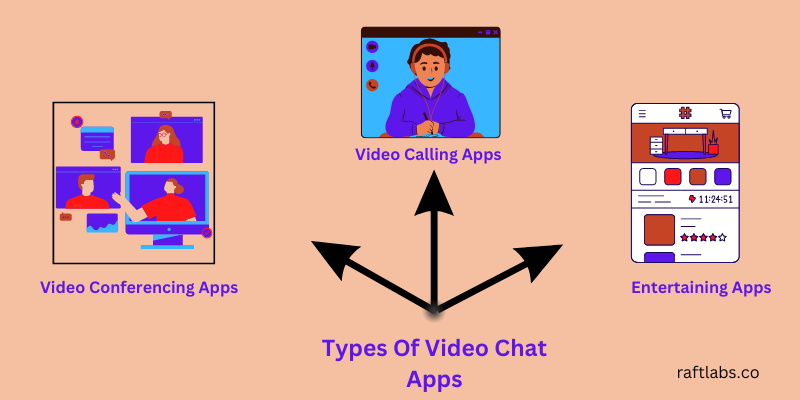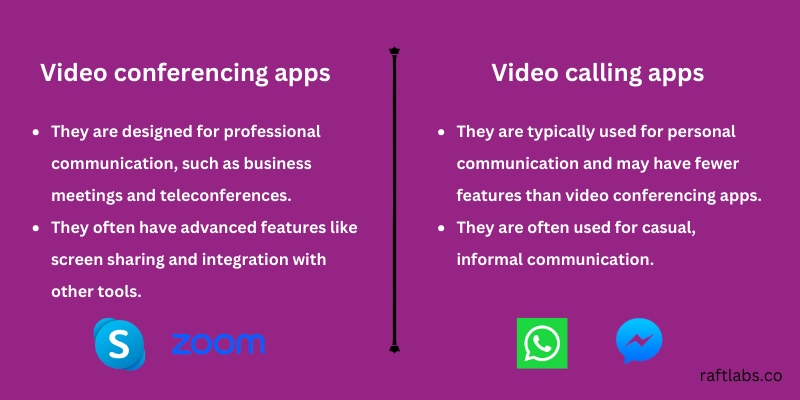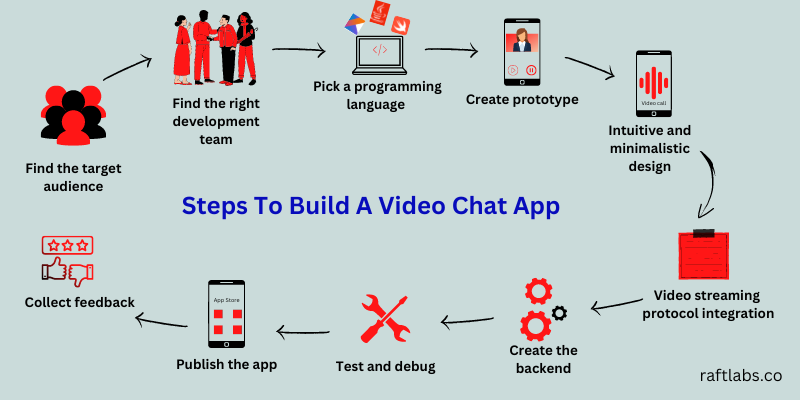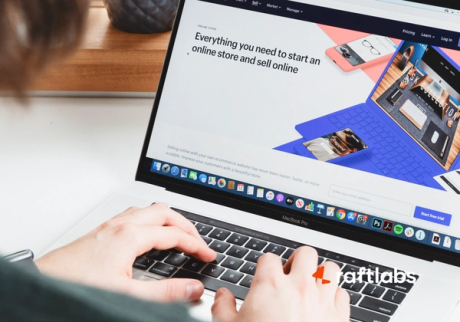How To Build A Video Call & Chat App?
The growing reliance on digital communication tools has significantly changed how we work and interact. With many people now using video chat apps for both professional and personal purposes, the landscape of communication is rapidly evolving. According to a study, 22% of the American workforce is expected to work virtually remotely by 2025, highlighting the increasing need for effective video call solutions.
Moreover, 52% of American adults have reported using live video chat for telemedicine with their healthcare providers, showcasing the rise of ondemand telehealth video calls. This trend has been further accelerated by the Covid-19 pandemic, which has driven widespread adoption of virtual and hybrid work models, as well as increased reliance on live video calls.
The global video conferencing market, valued at USD 28.61 billion in 2023, is expected to nearly double, reaching USD 60.17 billion by 2032, growing at an annual rate of 7.8%.
This article will help you understand how to create an optimal video chat application to thrive in this evolving landscape and achieve business success.
1. Types Of Video Chat Applications In The Market With Examples

Video Conferencing Apps
Video conferencing apps enable users to communicate via video and audio calls over the internet. These apps often have screen-sharing, messaging, and document-sharing features. Many rely on video conferencing apps for remote work, telemedicine, and virtual education. Here are some popular examples of video conferencing apps:
Skype
Features: Allows users to make voice and video calls. You can send instant messages and share photos and files with other Skype users. Available on different platforms, including desktop computers, smartphones, and tablets.
Zoom
Features: Allows users to hold meetings, webinars, and video conferences with up to 1000 participants. The app offers a variety of features, such as screen sharing, recording, and virtual backgrounds.
Google Meet
Features: It is a video conferencing platform that is part of the G Suite suite of productivity tools. It allows users to hold meetings and video calls with up to 250 participants. It offers features like screen sharing, recording, and integration with other G Suite tools.
Microsoft Teams
Features: It is a collaboration platform with a video calling feature. The app allows users to hold meetings and video calls with up to 250 participants. It offers features like screen sharing, recording, and integration with other Microsoft tools.
Video Calling Apps
These applications enable users to make video calls over the internet to other users, either one-on-one or in a group. These apps often allow people to create small conferences.
Features: It is a messaging app that allows users to send and receive text messages, photos, and videos. The voice and video calling feature permits users to make voice and video calls over the internet. The app is available on different platforms, including smartphones, tablets, and desktop computers.
Facebook Messenger
Features: It is a messaging app that is part of the Facebook social networking platform. It allows users to send and receive messages, photos, and videos with other Facebook users. It includes a voice and video calling feature that allows users to make voice and video calls over the internet. You can use the app on various platforms, including smartphones, tablets, and desktop computers.
FaceTime
Features: It is a video calling app exclusive to Apple devices, such as iPhones, iPads, and Mac computers. It allows users to make voice and video calls over the internet. The features include group calls and integration with other Apple apps. The app is pre-installed on all Apple devices and does not require a separate download or installation.
Live Video Chat and Live Video Call Apps
These applications enable users to engage in live video chat and live video calls, providing real-time interaction over the internet. These apps are often used for both personal and professional purposes.
Instagram Live
Features: Allows users to broadcast live videos to their followers and interact with them through comments and reactions in real-time. Live video chat is integrated with other Instagram features, enhancing user engagement.
Facebook Live
Features: Users can stream live videos to their friends, followers, or the public, and engage with viewers through comments. Live video call features are integrated, allowing real-time interaction.
On-Demand Video Apps
On-demand video apps provide users with the ability to access video content or connect with service providers instantly or at a scheduled time. These apps are often used in telehealth, professional consultations, and customer support.
Teladoc
Features: Connects patients with doctors for virtual medical consultations through on-demand video calls. Offers features such as appointment scheduling, medical records access, and prescription services.
Clarity.fm
Features: Allows users to book and conduct calls with experts in various fields via on-demand video sessions. Offers features such as payment integration and session recording.
Gal3n
Features: Provides a comprehensive platform for virtual primary care across various industries. Utilizes on-demand video technology to connect patients with healthcare providers, ensuring improved access to medical care. Features include real-time patient video and health data, appointment scheduling, medical records access, and prescription services. The platform supports various devices, including the G-Cart, G-Pod, and G-Stand, each equipped with necessary peripherals to conduct thorough medical examinations from any remote location.
These apps are transforming how people access and receive care, providing convenience and efficiency through on-demand video capabilities.
Live Stream Video Chat and Live Stream Video Call Apps
These apps combine the broadcasting capabilities of live streaming with the interactivity of video chat, enabling users to engage in live stream video chat and live stream video calls.
Twitch
Features: Primarily used for live streaming video games, but also supports live stream video chat and interactions with viewers through chat.
YouTube Live
Features: Allows users to stream live videos and engage with viewers through live stream video calls and chat, enhancing the interactive experience.

Difference between video conferencing and video calling apps
Entertaining Apps
These are video conference apps that entertain users. These apps allow users to chat while playing games, watching movies, listening to music, and other forms of media.
Teleparty
Features: Teleparty (formerly Netflix Party) is a browser extension that allows users to watch movies and TV shows together in sync. It includes a group chat feature so friends can discuss what they're watching in real-time. While it primarily focuses on synchronized streaming, it enhances the social viewing experience with a shared chat room. The extension is compatible with Google Chrome and Microsoft Edge browsers.
Discord
Features: Discord is a communication platform designed for gamers. The app allows users to connect via voice, video, and text. It also offers a variety of customization options and integrations with other gaming platforms. The app is available on iOS, Android, and desktop devices.
These apps enhance the social experience by combining live video chat with interactive and entertainment features, making virtual interactions more enjoyable and engaging.
2. How to Build A Video Chat App in 10 Steps?

- Determine the goal and target audience of the app. It will help you decide on your app's features and functionality. Identify the primary use case are you building it for personal use (consumers), business users, gamers, or for your enterprise communication?
- Once identified, review the landscape of such video apps that relate best to your use case. This will help you identify the minimum required capabilities and value add for your users.
- Hire an in-house team of developers or outsource your video app project to a software development team. Look out for their experience in building solutions in this vertical. Ask for your references and relevant case studies in video streaming and communication space.
- Pick a programming language and framework. Many choices are available, including React Native, Java, Kotlin, and Swift if it’s for mobile apps, React, angular, or Vue for web apps.
- Create a video chat app prototype. By prototyping its design and interactions, you can evaluate a video chat software's future appearance, interface structure, and usefulness.
- To implement the user interface, design and build screens and views for user interaction, such as login, main chat, and settings screens. For a wider audience, use an intuitive and minimalistic design and ensure technical proficiency for users of all ages.
- Create the backend of the video chat app. There are several options for creating it. One option is to build it from scratch, which provides greater flexibility, or to use the communication platform as a service (CPaaS) to save time.
- Video streaming protocol integration is vital for building a video call app. It connects users and transmits video and audio data in real-time. Different protocols like WebRTC, RTSP, and HLS are available. Let your product development team pick the right one according to the app's requirements and the devices.
- Test and debug the app. It will involve testing the app on various devices and fixing any issues.
- Publish the mobile app to the app store. It will involve submitting the mobile app to the appropriate app store (e.g., Google Play Store or Apple App Store) and following the submission guidelines.
- End-users play a crucial role in developing and building a video call app. They provide valuable resources for the development team in providing feedback and input.
3. What are the MVP features of a video chat app?
An MVP for your video chat app will enable users to utilize essential functions such as:
Consumer/Personal Communication Apps
- Initiating and participating in 1-1 or group video and audio calls
- Recording the calls
- Chats and Emojis
Business Communication Apps
- Initiating and participating in 1-1 or group video and audio calls
- Recording the calls
- Chats and Emojis/Text messaging.
- Meeting rooms
- Audio/Video Settings
- Security features
Let us learn the basic features a video call app’s MVP should possess.

Audio and video calls: The ability to initiate and partake in audio and video calls with other users is a video call app's primary feature.
Text messaging: Including a text messaging feature in the MVP allows users to communicate in real time, even if they cannot speak or have their cameras turned off.
Call quality: Ensuring good call quality is essential for user satisfaction. The MVP should prioritize call stability and minimize dropped calls and audio/video lag.
User authentication: Users should be able to create an account and log in with a unique username and password to access the app.
Contact list: Users should be able to easily add and view their contacts within the app and initiate calls with their friends and colleagues effortlessly.
Group calls: The MVP should allow users to initiate and participate in group calls with multiple users.
Call scheduling: For business use, it could be helpful to have a feature that enables users to schedule video calls ahead of time.
User interface: The MVP should have a user-friendly interface that is easy to navigate and understand.
Device compatibility: The MVP should be compatible with various devices, including desktop computers, laptops, tablets, and smartphones.
4. What are the advanced features of a video chat app?
Here are some advanced features that a video chat app may include:
Video and audio quality options: Users should be able to adjust the quality of their video and audio streams to suit their network connection and device capabilities.
Screen sharing: This feature permits users to share their screens with other participants in the call. It can be beneficial for presentations or collaborating on a document.
Meeting scheduling and calendar integration: Some apps include features for scheduling and organizing meetings and integrating with calendar apps like Google Calendar or Outlook.
Security and privacy controls: A video chat app must offer robust security and privacy controls, such as end-to-end encryption and setting passwords for calls.
Text chat and file sharing: Many video chat applications allow users to send text messages and share files.
Virtual backgrounds and filters: Some apps offer the ability to use virtual backgrounds or apply filters to your video stream to enhance the appearance of your video call.
Recording and transcription: Some video chat applications can record calls and provide transcriptions of conversations.
Integration with other apps and services: Most video chat applications can integrate with other apps and services, such as project management tools or CRM systems.
Virtual noise cancellation: This feature reduces or eliminates background noise during video calls, making it easier for participants to hear and understand each other.
Custom emojis and stickers: They allow users to add personalized and expressive details to their conversations through images or graphics.
Programming LanguagesiOS: SwiftAndroid: Kotlin, JavaWeb: React, Angular or VueFrameworksSpark, Node.jsDatabasesMySQL, OracleCloud PlatformsAmazon EC2, Amazon S3API & SDKCPaaS like Agora.io
5. Team Members To Build A Video Conference App
Project manager: The project manager is responsible for the overall planning and execution of the project, including setting milestones and deadlines, coordinating team members, and communicating with stakeholders.
UX/UI designer: the designer will design the interface and user experience and conduct user research and testing. They also create the visual design, including the layout and branding of the app, wireframing, prototyping, and user testing.
Front-end developer: A front-end developer is responsible for implementing the UI design and building the app's user-facing features using technologies such as HTML, CSS, and JavaScript.
Back-end developer: A back-end developer is responsible for building the app's server-side functionality, integrating any required APIs or databases, and handling data storage and security.
Quality assurance (QA) engineer: The QA engineer ensures the app's reliability by testing it, verifying that it performs as expected, and identifying and reporting any issues or bugs.
DevOps engineer: A DevOps engineer is responsible for maintaining the app's infrastructure and ensuring smooth deployment and operation, including monitoring and debugging any issues.
6. Cost Of Building A Video Call App
The cost of building a video call app will depend on various factors, such as
Complexity
Number of features
Platforms
Development team's size
The team’s experience.
A basic video call app may cost around US $15 to $25K. A more complex app with additional features and integrations may cost more than $50K. It's a good idea to consult with a software development company to get a more accurate estimate based on your specific requirements.
7. Monetization Strategy For Video Call App
There are several ways to monetize a video call app.
Subscription model: Users pay a monthly or annual fee to access the app's features. It is a common monetization model for video call apps that offer a premium service.
Freemium model: These apps are free to use. But, users will have to pay for additional features or to remove ads.
In-app purchases: Users can purchase other features or virtual items within the app.
Advertising: The app displays ads to users, and the developer earns revenue based on the number of ad impressions or clicks.
Partnering with businesses: The video conferencing app can offer paid business-oriented features or integrations, such as support for enterprise-grade collaboration tools or integration with CRM systems.
Offering paid services: The app can offer paid services such as professional consulting or support directly or through partnerships with other companies.
Choosing the right monetization strategy for your app is crucial, as it will influence the development and marketing efforts needed to create and grow the app.
RaftLabs Capabilities
Our services include building media and communication solutions -
To know more click here.
Relevant case studies
Voice chat web app for scalable decision-making
The goal was to create a high-quality software as a service product that could address all communication, engagement, and task management needs without requiring employees to use multiple tools. Through agile development and ongoing customer feedback, we were able to develop a product that significantly streamlines the work of hybrid teams by replacing a range of tools with a single solution.
Click here to learn more about the project>>
Hybrid remote working app
The aim was to create high-quality software as a service product that could address all communication, engagement, and task management needs without requiring employees to use multiple tools. Utilizing our expertise in developing software as a service product for remote team engagement and audio-video communication, we created a comprehensive app that combines communication, engagement, task management, and productivity features specifically designed for hybrid-remote teams.
Click here to learn more about the project>>
Summary
The cost of building a video chat app will vary based on various factors. Choosing the right monetization strategies can make your video chat app a profitable product.
If you want to develop a video chat app, RaftLabs can assist you in bringing your app idea to fruition. Our team of experienced professionals has the necessary skills and expertise to define the scope and features of your app, design a user-friendly interface, and build a robust and scalable backend. We will also support you with testing and deployment to help you launch and grow your app successfully. Please reach out to us to understand how we can help you build the video chat app of your dreams.
Frequently Asked Questions
How to make a video chat app from scratch?
To make a video call app from scratch, you will need to choose a programming language to build the front-end and back-end of the app, set up a server to handle the calls, and use a real-time communication library to enable the video and audio functionality. You may also need to integrate a login system and user database. The features of the video chat app will change according to your requirements.
How much does it cost to develop a video chat app?
The cost to develop a video chat app can vary widely depending on the features and complexity of the app. At RaftLabs, the cost to develop a basic video call app is generally between $10K and $20K. More feature-rich and complex apps may cost over $50K.
What are the monetization strategies for video call apps?
The monetization strategy depends on the features of your video calling app. There are several ways that video call apps can monetize their service, including offering premium features or functionality for a fee, selling virtual goods or in-app currency, displaying ads to users, and charging businesses or organizations for enterprise-level usage or custom integrations.
What are the key features of a live video chat app?
A live video chat app should include features such as high-quality video and audio calls, real-time messaging, file sharing, screen sharing, end-to-end encryption for security, user authentication, and a user-friendly interface.
How can I integrate live video call functionality into my app?
To integrate live video call functionality, you can use APIs and SDKs from providers like Twilio, Agora, or WebRTC. These tools offer ready-to-use solutions for handling video calls, including connection setup, media transmission, and user management.
What technologies are essential for building an on-demand video app?
An on-demand video app requires technologies such as a robust backend server, a reliable database, a CDN (Content Delivery Network) for efficient video streaming, and frontend technologies for mobile and web development like React Native, Flutter, or Swift.
How do I ensure low latency in a live stream video chat app?
To ensure low latency in a live stream video chat app, you should use a high-performance CDN, optimize your encoding settings, minimize server hops, and choose a streaming protocol like WebRTC that supports real-time communication.
What are the best practices for developing a live stream video call feature?
Best practices for developing a live stream video call feature include optimizing bandwidth usage, implementing adaptive bitrate streaming, providing a user-friendly interface, ensuring strong security measures, and offering interactive features like chat and reactions.
How can I build a telehealth video call app for medical consultations?
To build a telehealth video call app, focus on features such as secure patient authentication, HIPAA compliance, high-quality video and audio, appointment scheduling, EHR (Electronic Health Record) integration, and prescription services. Using platforms like Twilio or Vonage can simplify the integration process.
What are the benefits of using on-demand video in a business app?
Using on-demand video in a business app allows for flexible content delivery, improved user engagement, the ability to monetize through subscriptions or ads, and the convenience of accessing video content anytime, leading to better user retention and satisfaction.
How do I ensure security and privacy in a live video chat app?
Ensure security and privacy in a live video chat app by implementing end-to-end encryption, secure user authentication, regular security audits, compliance with data protection regulations, and providing users with privacy controls.
What are the cost factors involved in developing a live video call app?
The cost factors in developing a live video call app include development time, server and bandwidth costs, third-party API and SDK fees, security measures, maintenance, and updates. Additionally, the complexity of features and platform compatibility (iOS, Android, web) will impact the overall cost.
How can I measure the performance of my live stream video chat app?
Measure the performance of your live stream video chat app by monitoring metrics such as latency, video and audio quality, connection stability, user engagement, and server performance. Use analytics tools to gather data and continuously optimize the app's performance.

Riya Thambiraj
Creative content writer at RaftLabs
Insights from our team
Ready to build
something amazing?
With experience in product development across 24+ industries, share your plans,
and let's discuss the way forward.










